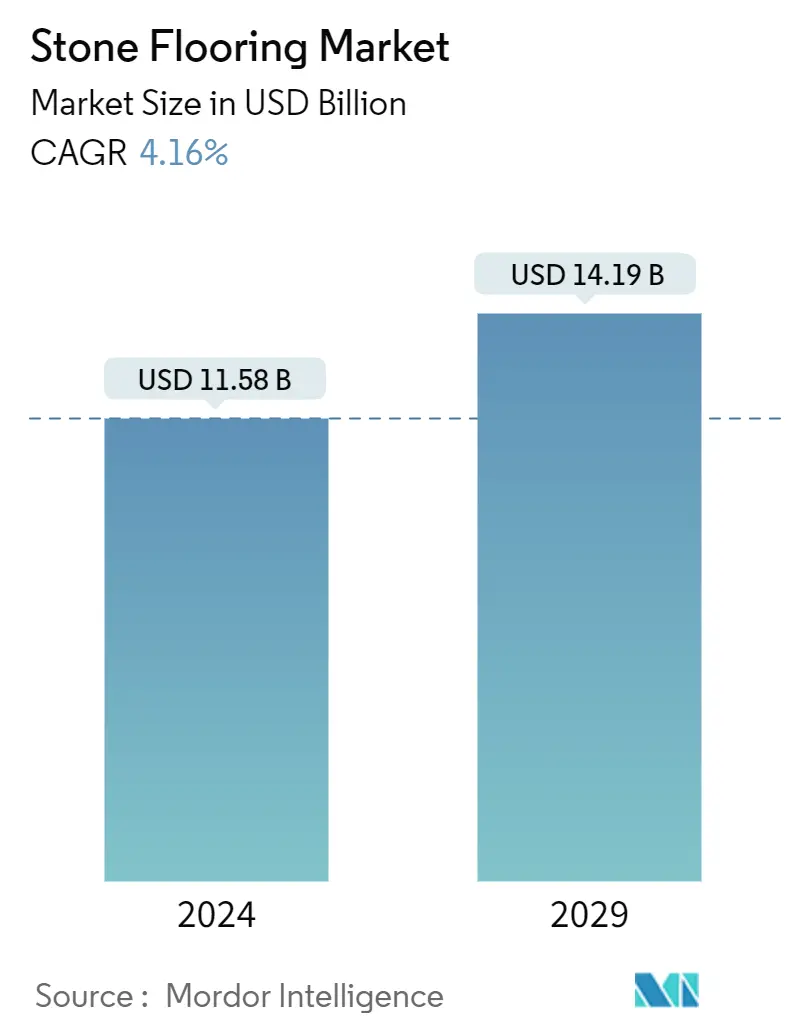Market Size of Stone Flooring Industry

| Study Period | 2020-2029 |
| Market Size (2024) | USD 11.58 Billion |
| Market Size (2029) | USD 14.19 Billion |
| CAGR (2024 - 2029) | 4.16 % |
| Fastest Growing Market | Asia Pacific |
| Largest Market | North America |
Major Players
*Disclaimer: Major Players sorted in no particular order |
Stone Flooring Market Analysis
The Stone Flooring Market size is estimated at USD 11.58 billion in 2024, and is expected to reach USD 14.19 billion by 2029, growing at a CAGR of 4.16% during the forecast period (2024-2029).
The market is growing rapidly, owing to the increasing construction, renovation, and retrofitting activities. Demand for stone floors is growing in the construction industry, as it is available in various colors and sizes and can be used as a decorative tool for both commercial and residential purposes. The increase in the purchase of aesthetically appealing products is also projected to fuel the growth of the stone flooring market in the next few years.
One of the primary factors promoting a favorable market outlook is the construction industry's notable global growth. The market is expanding because of the growing demand for modern and aesthetically pleasing interiors in residential and commercial buildings. Additionally, stone, especially marble, is becoming more and more popular as a premium floor surface for monuments, hotels, theatres, commercial buildings, and churches. The growing awareness of environmental issues is also contributing to this growth. Contemporary stone flooring exhibits low to nonexistent emissions of formaldehyde and volatile organic compounds (VOCs), as well as resistance to stains, fire, and slippage.
Stone Flooring Industry Segmentation
Stone flooring, also known as natural stone flooring, is a flooring material made from natural stone. Natural stone flooring is made from a variety of natural stone materials, including granite and marble, as well as limestone and travertine.
The stone flooring market is segmented by product, application, end-user, and by region. By product, the market is segmented into slate, granite, marble, limestone, travertine, sandstone, and others (brushed, slate, etc). By application, the market is segmented into flooring, wall cladding, and cut-to-size items. By end-user, the market is segmented into residential and commercial. By region, the market is segmented into North America, Europe, Asia-Pacific, South America, and Middle East, and Africa.
The report offers market size and forecasts for the stone flooring market in value (USD) for all the above segments.
| By Product | ||||||||
| ||||||||
| ||||||||
| ||||||||
|
Stone Flooring Market Size Summary
The stone flooring market is experiencing significant growth, driven by the increasing activities in construction, renovation, and retrofitting. This growth is fueled by the rising demand for stone floors in the construction industry, where they are valued for their aesthetic appeal and versatility in both commercial and residential settings. The market's expansion is further supported by the global growth of the construction industry, which is seeing a heightened demand for modern and visually appealing interiors. Stone flooring, particularly marble, is gaining popularity as a premium choice for various high-end applications, including monuments, hotels, and commercial buildings. Additionally, the environmental benefits of contemporary stone flooring, such as low emissions and resistance to stains and fire, are contributing to its growing adoption.
The trend of global urbanization is increasing the need for both residential and non-residential infrastructure, with significant growth anticipated in the construction sectors of the United States, China, and India. The Asia-Pacific region, in particular, is witnessing rapid economic expansion and a surge in construction projects, driven by population growth and the demand for sustainable buildings. India's commercial real estate market is also expanding, supported by the rise of startups and businesses in major cities. The stone flooring market is characterized by fragmentation, with major players like Stone Source and Emser Tile dominating through strategic product offerings and marketing. Recent developments, such as Emser Tile's introduction of new tile sets and the acquisition of Stone Source by Paramount Global Surfaces, highlight the dynamic nature of the market.
Stone Flooring Market Size - Table of Contents
-
1. MARKET DYNAMICS
-
1.1 Market Drivers
-
1.1.1 Increased Demand for Aesthetically Appealing Products to Fuel the Growth of the Stone Flooring Market
-
1.1.2 Demand for Stone Floors as a Decorative Tool in the Construction Industry
-
-
1.2 Market Restraints
-
1.2.1 High Initial Cost
-
1.2.2 Lack of Skilled Labor
-
-
1.3 Market Opportunities
-
1.3.1 Rising Consumer Spending is Expected to Boost the Future Growth of the Market
-
1.3.2 Expansion in the Growing Preference for Stones in Commercial and Residential Segment
-
-
1.4 Porter's Five Forces Analysis
-
1.4.1 Bargaining Power of Suppliers
-
1.4.2 Bargaining Power of Buyers/Consumers
-
1.4.3 Threat of New Entrants
-
1.4.4 Threat of Substitute Products
-
1.4.5 Intensity of Competitive Rivalry
-
-
1.5 Impact of COVID-19 on the market
-
1.6 Insights Into Technological Advancements in the Stone Flooring Market
-
-
2. MARKET SEGMENTATION
-
2.1 By Product
-
2.1.1 Slate
-
2.1.1.1 Granite
-
2.1.1.2 Marble
-
2.1.1.3 Limestone
-
2.1.1.4 Travertine
-
2.1.1.5 Sandstone
-
2.1.1.6 Other Products
-
-
2.1.2 By Application
-
2.1.2.1 Flooring
-
2.1.2.2 Wall Cladding
-
2.1.2.3 Cut-to-size
-
-
2.1.3 By End-User
-
2.1.3.1 Residential
-
2.1.3.2 Commercial
-
-
2.1.4 By Geography
-
2.1.4.1 North America
-
2.1.4.2 Europe
-
2.1.4.3 Asia-Pacific
-
2.1.4.4 South America
-
2.1.4.5 Middle East and Africa
-
-
-
Stone Flooring Market Size FAQs
How big is the Stone Flooring Market?
The Stone Flooring Market size is expected to reach USD 11.58 billion in 2024 and grow at a CAGR of 4.16% to reach USD 14.19 billion by 2029.
What is the current Stone Flooring Market size?
In 2024, the Stone Flooring Market size is expected to reach USD 11.58 billion.

